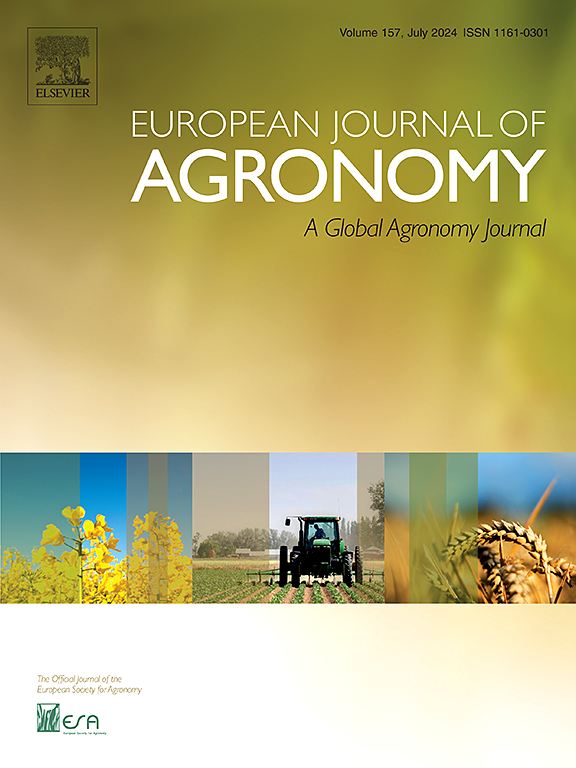Livestock excreta facilitate invasive weed establishment and dominance in pastures through physical niche creation and nutrient pulses
IF 4.5
1区 农林科学
Q1 AGRONOMY
引用次数: 0
Abstract
Globally, invasive weeds jeopardize pasture productivity and biodiversity, prompting extensive control efforts which are often hampered by an incomplete understanding of how livestock activities, particularly excreta deposition, facilitate weed invasion. Focusing on southwest Chinese pastures, we combined field surveys and controlled experiments to investigate how livestock excreta facilitate the establishment and dominance of the global invasive weed Rumex obtusifolius L. through physical and nutrient-mediated pathways. Field surveys confirmed a strong positive association between excreta deposition and the distribution of R. obtusifolius across diverse pasture landscapes. Experimental manipulations revealed a two-stage facilitation mechanism: (1) Initial physical suppression by dung patches (via light exclusion and anaerobic soil) eliminated intolerant species, substantially reducing local richness (61.6 % after 30 days) and creating establishment opportunities; and (2) Subsequent multi-nutrient enrichment from overlapping dung and urine deposition promoted R. obtusifolius dominance, with dung addition increasing R. obtusifolius height ∼10-fold and ramet number ∼11-fold compared to controls (p < 0.001). Combined dung-urine treatments amplified growth by 32.4 % (p = 0.002) through stoichiometric complementarity, where nitrogen emerged as the primary growth driver (91.3 % biomass increase; p < 0.001). Crucially, clonal reproduction required concurrent multi-nutrient availability, averaging nearly 4 ramets/plant, compared to less than 1 in nitrogen treatments. These findings directly inform pasture management, highlighting that effective invasive weed control and productivity maintenance in pastoral systems require integrating livestock excretion management. Practical strategies, such as adjusting grazing patterns and targeted excreta removal, limit localized nutrient over-enrichment and help conserve pasture ecosystems in an ecologically sound manner.
牲畜排泄物通过建立生态位和养分脉冲促进入侵杂草在牧场的建立和优势地位
在全球范围内,入侵杂草危害牧场生产力和生物多样性,促使人们进行广泛的控制工作,但由于对牲畜活动(特别是排泄物沉积)如何促进杂草入侵的认识不完全,这些努力往往受到阻碍。本文以中国西南草原为研究对象,采用野外调查和对照实验相结合的方法,研究了家畜排泄物如何通过物理和营养介导途径促进全球入侵杂草瘤胃(Rumex obtusifolius L.)的建立和优势地位。野外调查证实,粪便沉积与不同牧草景观中粗叶红的分布呈显著正相关。实验操作揭示了两个阶段的促进机制:(1)粪块的初始物理抑制(通过避光和厌氧土壤)消除了不耐物种,大幅降低了当地丰富度(30天后为61.6 %)并创造了建立机会;(2)重叠的粪便和尿液沉积的多重营养物质富集促进了obtusifolius的优势,与对照组相比,粪便添加使obtusifolius高度增加~ 10倍,分株数量增加~ 11倍(p <; 0.001)。粪尿联合处理通过化学计量补补性使生物量增加了32.4 % (p = 0.002),其中氮成为主要的增长动力(生物量增加91.3 %;p & lt; 0.001)。最关键的是,无性系繁殖需要同时使用多种营养物质,平均每株近4株,而氮肥处理则不到1株。这些发现直接为牧场管理提供了信息,强调了有效的入侵杂草控制和畜牧业系统的生产力维持需要整合牲畜排泄物管理。切实可行的策略,如调整放牧模式和有针对性的排泄物清除,限制了局部营养物质的过度富集,并有助于以生态无害的方式保护牧场生态系统。
本文章由计算机程序翻译,如有差异,请以英文原文为准。
求助全文
约1分钟内获得全文
求助全文
来源期刊

European Journal of Agronomy
农林科学-农艺学
CiteScore
8.30
自引率
7.70%
发文量
187
审稿时长
4.5 months
期刊介绍:
The European Journal of Agronomy, the official journal of the European Society for Agronomy, publishes original research papers reporting experimental and theoretical contributions to field-based agronomy and crop science. The journal will consider research at the field level for agricultural, horticultural and tree crops, that uses comprehensive and explanatory approaches. The EJA covers the following topics:
crop physiology
crop production and management including irrigation, fertilization and soil management
agroclimatology and modelling
plant-soil relationships
crop quality and post-harvest physiology
farming and cropping systems
agroecosystems and the environment
crop-weed interactions and management
organic farming
horticultural crops
papers from the European Society for Agronomy bi-annual meetings
In determining the suitability of submitted articles for publication, particular scrutiny is placed on the degree of novelty and significance of the research and the extent to which it adds to existing knowledge in agronomy.
 求助内容:
求助内容: 应助结果提醒方式:
应助结果提醒方式:


